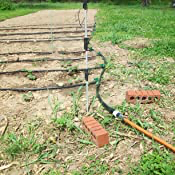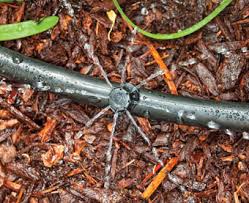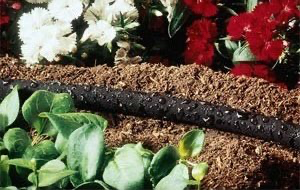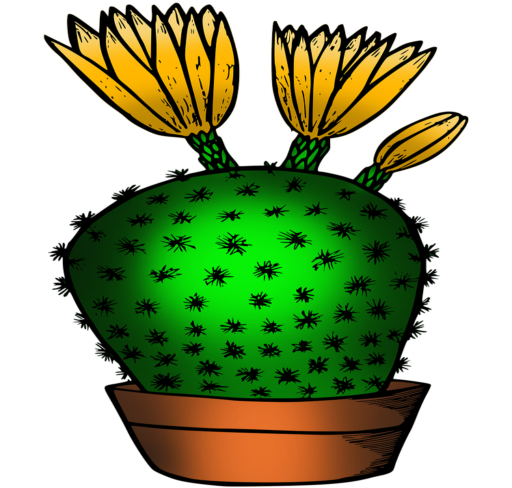Getting Water to Your Plants
The object of water use in the desert is to conserve the water whenever possible. There are many water conservation methods that can be used when watering the garden. A gardener of the desert must learn to live with the limitations of the climate.
Water Properly to Improve Yields
In the dry climate, irrigation is fundamental in desert gardens. Too little water can provoke plant stress. However, overwatering can cause root rot or cause plants to stay too leafy. Providing a good balance of irrigation to plants as they grow will avoid plant stress and provide healthy crops.
After planting the garden, water lightly every 2 days until seeds sprout and plants are started. After plants are up and growing, water less often but more deeply. Allow the surface soil to dry out between irrigations. This will promote deeper root growth and eventually making plants more drought resistant.
Plants prefer to be watered underneath the canopy of leaves. Thus the dry plants will not have the opportunity to be susceptible to a condition called powdery mildew. You want to water the soil rather than the plants and the soil in turn feeds and waters the plants.
Watering deep and infrequently is the best way to establish strong plants. It also causes the roots to grow down as they seek the water and enables them to develop and grow strong.
Drip Irrigation Systems and Water Conservation

There are many DIY garden drip irrigation systems. This watering method is widespread not only because of its effectiveness, but also because of the amount of water it saves, conserving both time and money.
Several choices exist for irrigating your garden, and each one has its benefits and limitations. The size, location, and configuration of your garden will influence which system works best for you.
Drip irrigation is a low-pressure, low-volume garden watering system that delivers water to home gardens in a variety of methods. A drip irrigation system keeps roots moist, but not soaked, using less water than other irrigation techniques.
You can hide much of the system under a layer of mulch. Keep any part that emits water on top of the mulch to prevent clogging. The system can also run on top of the soil or mulch. As a result, that allows the plants to conceal it as they grow and spread.
Advantages of a Drip Irrigation System
Drip irrigation provides minimal evaporation and lower water use resulting in lower cost and better water conservation. Drip systems consist of several parts, all of which are easy to install. You can water different zones at the same time. Drip irrigation an appropriate choice for gardens.
The system can be a directly connection to the hose spigot. Supply lines can lie on the ground. Drip systems work well on timers. In addition they can easily be scheduled to operate in the early morning in hot climates when evaporation is least likely to happen.
The drip system will allow for flexibility as your plants grow and spread. Customization for containers, raised beds, or vegetable rows. Careful delivery, averting delivery of water where it’s not needed.
Mild, precise watering that minimizes erosion. Drip irrigation systems deliver water directly to the base of your plants. Since drip systems generally water slowly the water penetrates over a broad circle and deep into the root zone.
Limitations to Drip Water Systems
The emitters on drip systems can become blocked, needing regular inspection and some maintenance. In some systems, emitters may blow-out and require replacement. This happens in Southwestern gardens due to the high amount of minerals in the water. The water evaporates clogging the small emitter openings with mineral deposits.
Drip systems often involve some up-front investment. They also take time and planning to set up.
Drip Irrigation System Components

You can find kits to create systems for vegetable gardens. Kits allow you to expand the system as your irrigation needs grow.
Back-flow preventers or anti-siphon devices prevent the irrigation system’s water from re-entering your water supply and contaminating your drinking water when the system is turned off.
Pressure regulators or reducers make home pressure compatible with the drip irrigation system. Filters prevent debris from clogging the tubing and emitters. Flexible tubing transports the water. Black or brown coloring allows the tubing to blend in with soil and mulch. Fittings connect system components.
Stakes secure tubing and support emitters to prevent clogging by soil, debris or bugs and timers turn the water on and off at times set. Timers can stop overwatering.
Hole punches create insertion points in the tubing to connect emitters or smaller-diameter tubing. Cutters make clean cuts in different sized tubing. Plugs tightly stop up holes you pierced by mistake.
Emitters insert into the tubing and release the water into the soil or onto plants. A gallons-per-hour (GPH) rating designates the flow rate. Most emitters have a rating for the maximum water pressure they can accept, noted in pounds per square inch (PSI). Pressure compensating emitters deliver a constant flow rate even if the water pressure differs.
Water Soaker Hoses

A soaker hose is a permeable tube that looks like a garden hose. However, it seeps water along its entire length. Placed on the top of your soil, soaker hoses deliver water steadily to your plants. Most soaker hoses are made from some combination of rubber and polyethylene plastic.
Benefits
Soaker hoses provide dependable water delivery at soil level. Most importantly, helping the foliage on your plants remain dry and free from fungal growth. Installing a soaker hose is easy. Hook up to the closest faucet and wind around the plants you want watered.
Pressure controllers are not needed with soaker hoses. You can adjust the water pressure by opening or closing the tap. Soaker hoses ordinarily have a low up-front cash outlay. They work well on timers to conserve water. Clogging is not usually an issue.
Limitations
Soaker hoses are not as flexible in their arrangement potentials as drip systems. Soaker hoses work best on horizontal ground. The range of exposure is not quite as wide with soaker hoses as it is with drip systems.
Soaker hoses are less accurate than drip systems and can’t be connected underground. Sun damage and dilapidation can also take place over time.
Getting the Most from Your Irrigation System
Cover your irrigation lines (drip or soaker hoses) with 2-3 inches of mulch to protect from sunlight. Do not bury soaker hoses with soil unless they are designed for this purpose or you may clog the pores. If you plan to bury your drip irrigation, ensure that you have the type meant for subsurface installation.
Stake down drip lines about once every three feet using landscaping staples. Once or twice per season, clean the in-line water filter (if you have one) to remove any rust or debris.
Inspect your system occasionally during the season to remove plugs, straighten kinks, and ensure even moisture delivery. Ideally, drain and put away all hoses and water lines during the dormant season. Store in an enclosed site.
Other types of drip irrigation systems include:
Drip Tape
This flat-style tubing requires a pressure reducer in the waterline to work optimally. It works well for subsurface installations but isn’t typically manufactured to last more than a few years.
Drip Line
This round tubing is manufactured with heavier duty plastic that will work well for many years. You can purchase drip line with pre-installed emitters or separate emitters that you install yourself.
Exciting Irrigation Improvements
Over the years, irrigation systems have improved and are now more high-tech than ever before. With remote and smart irrigation systems, you can proficiently and efficiently water your gardens anyplace at any time.
Many irrigation systems can be linked to your phone. This will allow you to download an application. Then cleverly monitor your irrigation system. This technology provides you with the ability to manage your irrigation systems. No matter where you are and is indispensable for gardeners who travel often or who are away from home.
https://www.pntra.com/t/SkNKTUdNTUlDSElPTUxJQ0hMT0ZNSQ
Check the following posts for more information:
Gardening Tools
